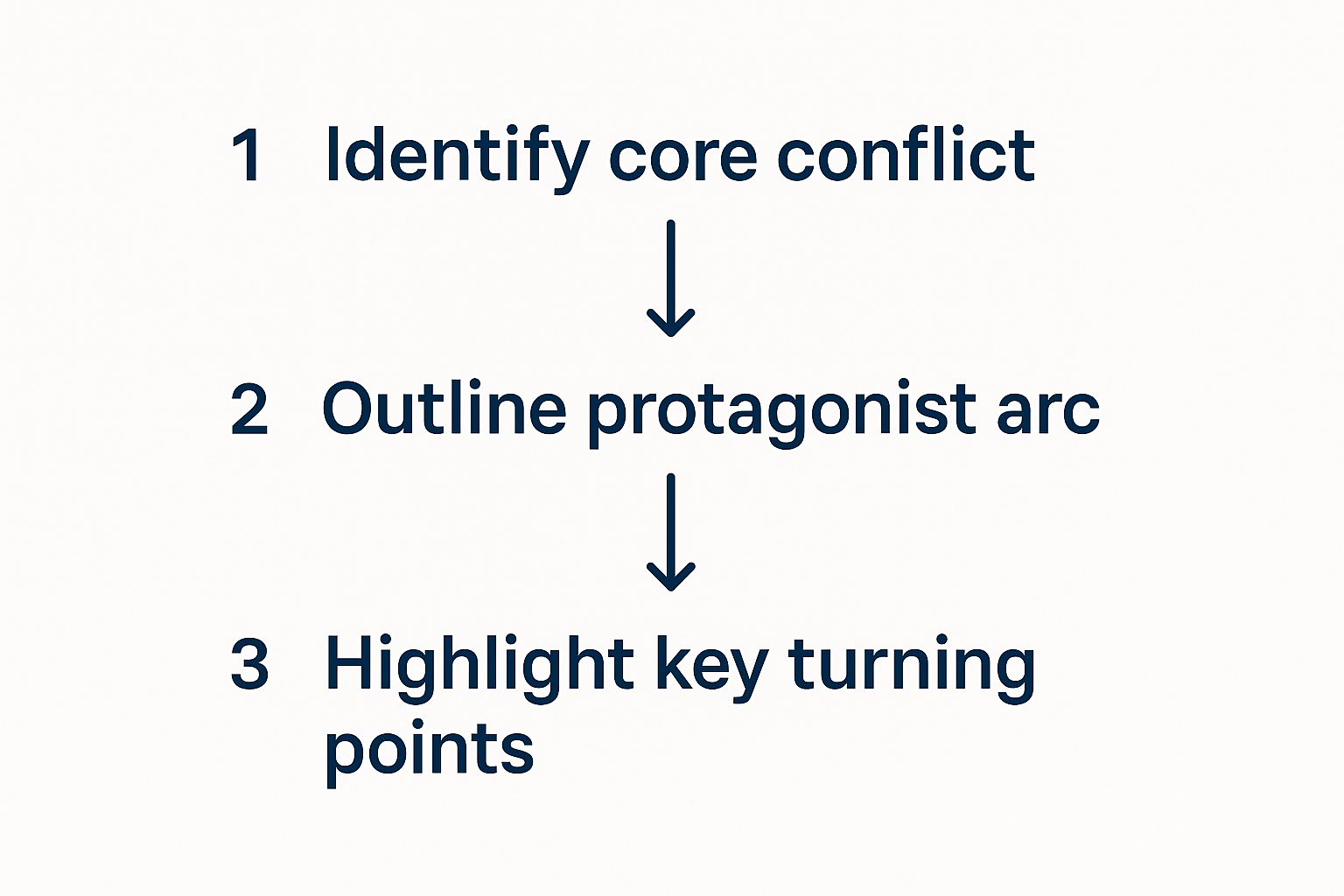Let's be real—nobody really enjoys writing a book synopsis. Trying to squeeze your entire, complex novel, with all its nuance and subplots, onto a single page can feel like an impossible, soul-crushing task. But here's the thing: a great synopsis isn't just a summary. It's one of the most powerful sales documents in your entire query package, proving to an agent that your story actually works.
Your Synopsis Is a Strategic Sales Tool

Most writers treat the synopsis like a chore, just another box to check on the submission list. The first step to getting it right is to shift your perspective. This isn't just a dry retelling of your plot; it's your novel's resume. You're not writing for a casual reader browsing a bookstore. You're writing for a literary agent or an editor—a busy industry pro who has to make snap judgments all day long.
Think of it as their first real look under the hood of your manuscript. They use it as a diagnostic tool to check the engine of your story before they commit to reading 300+ pages.
For them, a well-crafted synopsis answers a few critical questions almost instantly:
- Is there a clear and compelling plot here?
- Does the main character go through a meaningful and logical transformation?
- Does this author know how to structure a story with a satisfying beginning, middle, and, crucially, an end?
Answering "yes" to these questions is what gets your manuscript moved to the top of their reading pile. A weak or confusing synopsis, on the other hand, is a fast track to a rejection, no matter how beautiful your prose might be.
Synopsis vs Blurb Key Differences
It's easy to confuse a synopsis with a blurb, but they serve completely different functions for different audiences. The blurb is a teaser for readers; the synopsis is a detailed blueprint for industry insiders. Understanding this distinction is key.
| Element | Book Synopsis (For Agents/Editors) | Book Blurb (For Readers) |
|---|---|---|
| Purpose | To prove the story has a solid structure and satisfying arc. | To entice readers to buy the book. |
| Audience | Literary agents, editors, and publishing staff. | Potential readers and book buyers. |
| Key Feature | Reveals everything, including the ending. Spoilers required. | Creates mystery and intrigue. No spoilers. |
| Length | Typically 1-2 pages, around 500-800 words. | Short and punchy, usually 150-200 words. |
| Tone | Professional, clear, and objective. | Persuasive, evocative, and emotional. |
Getting this right shows an agent you understand the business side of publishing.
More Than a Summary It's a Professional Test
Agents wade through hundreds of queries a week. Your synopsis is your chance to prove you get it—that you understand the fundamental architecture of a good story. This is not the place for clever cliffhangers or coyly hiding your big twist.
The entire point of a synopsis is to spoil everything. It’s how you show an agent that you can deliver on the promises made in your query letter, by laying out every major plot point, character arc, and—most importantly—the resolution.
This is your first, and often only, opportunity to signal that you’re a professional who respects their time. A strong synopsis tells them you’ve done the hard work of building a solid story and that you’re ready to be a serious partner in the publishing journey.
Think of your synopsis as a key piece of your author platform. It’s part of a bigger picture that includes how authors can turn PR into a long-term visibility strategy. With the market more crowded than ever, this kind of strategic thinking is essential. In fact, with fiction sales on the rise in 16 out of 18 international markets, a polished, professional synopsis is one of the best ways to cut through the noise.
The Anatomy of a Compelling Synopsis
A truly effective synopsis follows a time-tested blueprint. Don't think of it as a simple summary. It’s more like an x-ray of your novel's skeleton, proving that the story you've built is solid from start to finish. An agent isn't just looking for a cool concept; they're looking for a complete, well-structured narrative, and your synopsis is the first piece of evidence you'll provide.
Mastering this format is about more than just listing events. It’s your chance to show an agent, with precision and clarity, that you understand the art of storytelling and have crafted a book that delivers on its promise.
Introduce the Core Elements
Your first paragraph needs to hit the ground running. You have to be sharp, efficient, and immediately establish three key things:
- The Protagonist: Introduce your main character by name, but don't stop there. Define them by their core desire. What is the one thing they want more than anything else in the world?
- The World: Quickly set the scene. Are we in a gritty, rain-slicked futuristic city? A quaint small town harboring dark secrets? Or perhaps a magical realm teetering on the brink of war? A few descriptive words are all you need.
- The Inciting Incident: This is the spark that lights the fuse. What specific event shatters your protagonist's everyday life and throws them headfirst into the story’s central conflict?
Nailing these elements right away grounds the agent in your story's reality. More importantly, it shows them you know how to build a strong foundation for a compelling plot.

As you can see, a successful synopsis hinges on a clear line connecting your protagonist's journey directly to the core conflict and its crucial turning points.
Map the Narrative Arc
Once the stage is set, the body of your synopsis needs to trace the protagonist's journey. This isn't a play-by-play of every single scene. Instead, focus on the major plot points that escalate the tension and force your character to change and grow. You have to show a clear chain of cause and effect, demonstrating how each event logically propels the story to the next.
A synopsis proves you can tell a great story. It demonstrates a complete narrative arc, which is the number one thing agents look for to confirm your manuscript delivers on its premise from beginning to end.
You'll want to highlight the rising action—the key trials and tribulations your hero faces. What are their biggest wins? What are their most devastating setbacks? Zero in on the choices they make that raise the stakes and push them ever closer to the story's ultimate showdown. This is where you prove the middle of your book isn't just filler; it's a crucible.
Reveal the Climax and Resolution
This is the step that makes many writers nervous, but it's absolutely non-negotiable. You must spoil the ending. An agent needs to see how the story concludes to judge its narrative satisfaction and commercial potential. There's no room for cliffhangers here.
Detail the climax—that final, explosive confrontation where the central conflict comes to a head. Then, you need to explain the resolution. What happens in the immediate aftermath? Crucially, how has your protagonist been fundamentally changed by their journey? What does their "new normal" look like? Showing this proves your story is a complete and satisfying package.
A great synopsis walks a fine line between detail and brevity. Industry standards generally call for a length of 500 to 800 words. This gives you enough space to cover the full story arc—including the ending—which is exactly what separates a professional synopsis from a simple book blurb. You can dive deeper into publishing market trends and insights to get a better feel for these expectations.
Drafting Your Synopsis: From the Hook to the Final Page

Alright, this is where the rubber meets the road. Moving from theory to actually writing the synopsis can feel like a huge leap, but trust me, it’s a skill you can build. Your goal is to create a document that proves your story is a complete, satisfying journey, flowing logically from that initial hook right through to the resolution.
Think of it less like a dry summary and more like building a model of your novel. You’re not just listing events; you’re strategically showcasing your story’s architecture, one crucial piece at a time.
Nailing the Opening Hook
Your first paragraph is everything. It’s your handshake, your elevator pitch, and your first impression all rolled into one. You have to immediately ground the reader in your character’s world and introduce the conflict that sends it spinning.
There's no time for a leisurely warm-up here. Be direct. An agent needs to grasp who your protagonist is, what they want, and what just happened to shatter their status quo—all within the first few sentences.
For instance, don’t start with something passive like, "John has worked as a quiet librarian for twenty years." Instead, jump right into the action: "For two decades, librarian John has curated a life of quiet order. That life implodes when he finds a coded message in a returned book, a message linking his long-lost brother to a city-wide conspiracy." See the difference? The second version is active, loaded with stakes, and makes you want to know what happens next.
Navigating the Murky Middle
The middle of the synopsis is a minefield. This is where so many writers get bogged down, feeling the need to include every brilliant twist, every beloved secondary character, and every clever subplot they’ve spent months crafting.
You have to fight that impulse. Your only job here is to trace the main plotline and your protagonist’s emotional journey. Stick to the major turning points—the moments that escalate the core conflict and force your main character to act, evolve, and change. Think in a straight line of cause and effect.
A crucial tip: A synopsis isn’t a substitute for the book. It’s a road map of its core journey. If a character or event doesn’t directly push the main plot toward its climax, it almost certainly doesn't belong here.
A good gut check is to ask yourself, "Does this scene directly affect the hero's ability to achieve their goal?" If the answer is no, be ruthless and cut it. This kind of disciplined focus is a key part of the entire book writing process that signals professionalism.
Sticking the Landing: The Ending
This might be the most counterintuitive part for new writers, but it's absolutely non-negotiable. You must reveal the ending. An agent needs to see that you can not only build tension to a thrilling climax but also deliver a resolution that feels earned and satisfying.
Here’s exactly what your final paragraphs should cover:
- The Climax: Describe the final showdown. How does your protagonist face the antagonist or the central conflict head-on?
- The Resolution: What’s the immediate fallout? Who wins, who loses, and what are the consequences?
- The Character's New Reality: Show us how your protagonist has been fundamentally changed by their ordeal. What does their life look like now?
Spoiling the ending isn’t a mistake; it’s a sign of confidence. It tells an agent you’ve thought your story all the way through. While crafting this ending is all you, for writers who want a bit of help structuring their narrative during the drafting phase, some of the best AI book writer tools can be surprisingly useful for organizing plot points.
Refining Your Voice and Polishing for a Professional Finish
A synopsis that checks all the boxes is one thing. A synopsis that sings with your unique authorial voice? That’s what gets you noticed. Once you've got the structural bones in place, the final polish is what will lift your submission out of the slush pile. This is your first—and maybe only—chance to give an agent a real taste of your writing style.
Think of it like this: the structure proves you know how to build a solid house, but your voice shows them how you’ll decorate it. Is your manuscript sharp and witty? Dark and brooding? Sweeping and romantic? Your synopsis needs to reflect that same energy.
This doesn't mean you should cram it full of purple prose. It’s all about making smart, strategic word choices that evoke the atmosphere of your book. Use the same kind of vocabulary and sentence rhythm you'd find in your novel, just in a much more concentrated form.
Trim the Fat and Strengthen Your Language
Every single sentence in your synopsis has a job to do. There's simply no room for filler. You have to be absolutely ruthless in your editing. Comb through your draft with a critical eye and cut anything that doesn't push the plot forward or reveal something essential about a character's motivation.
Here’s a quick hit list of things to hunt down and eliminate:
- Passive Voice: Flip those sentences around to make them active and impactful. Instead of "The decision was made by the council," go with "The council made the decision." It’s more direct and has more energy.
- Weak Verbs: Swap out tired, generic verbs like "walked" or "said" for ones that carry more weight and imagery. Did your character "stride," "stumble," or "creep"?
- Adverb Overload: Good, strong verbs rarely need an adverb to prop them up. Instead of "ran quickly," why not use "sprinted" or "bolted"? It's one word doing the work of two.
Beyond just the structure, infusing your synopsis with a compelling voice is what truly makes it shine. You can even explore proven techniques to boost your creativity to help your unique style stand out and connect with agents.
A polished synopsis sends a clear signal to an agent: you are a professional who takes this seriously. It shows you care about the details, which suggests you've put that same level of care into your 400-page manuscript.
Stick to Professional Formatting
Finally, let's talk about presentation. How your document looks can be just as important as what it says. Messy or incorrect formatting is an instant red flag for agents. It screams "amateur," and you don't want to be dismissed before they've even read your first sentence.
While you should always double-check the specific submission guidelines for each agent or publisher, the industry standard is blessedly straightforward.
- Font: Times New Roman, 12-point. Clean and classic.
- Spacing: Single-spaced paragraphs, but with a double space between each paragraph.
- Margins: Standard one-inch margins on all sides.
- Length: The sweet spot is one page, which usually comes out to around 500 words. Never, ever go over two pages unless the guidelines explicitly say it's okay.
Submitting a clean, professionally formatted document is the final, crucial step. It's the firm, confident handshake that comes right before you introduce them to your story.
Common Synopsis Mistakes That Can Kill Your Chances
Even the most talented writers I know can get tripped up by the synopsis. It’s totally understandable. After you’ve poured everything into your manuscript, it’s tough to switch gears and summarize it all. But some common, avoidable mistakes can send your query right to the rejection pile.
Learning what agents immediately see as red flags is your best defense against a quick "no."

Most of these blunders come from one simple misunderstanding: you're writing for a potential business partner, not a casual reader. An agent isn't there to be entertained—they're there to evaluate the very architecture of your story.
Mistake 1: Hiding the Ending
This is, without a doubt, the cardinal sin of synopsis writing. I see it all the time. Authors try to be clever, leaving the agent on a cliffhanger to build suspense. It backfires. Every. Single. Time.
An agent needs to see the whole story arc. They have to understand the climax, the resolution, and how your protagonist has fundamentally changed by the end. This is how they judge the story’s narrative strength and whether it will satisfy readers.
Think of your synopsis as a diagnostic tool, not a movie trailer. Hiding the ending doesn’t create intrigue; it just tells the agent you either don’t understand the purpose of a synopsis or you aren’t confident in your own ending.
Don't do this: "Will Detective Harding catch the killer before he strikes again, or will the city's dark secret be buried forever?"
Do this instead: "Harding confronts the killer—his own mentor—in a tense standoff at the docks. He exposes the deep-seated corruption but shatters his career in the process, forcing him to leave the city to find his own kind of peace."
Mistake 2: Overcrowding the Story with Characters
Your novel might have a rich, sprawling cast of 20 incredible characters, but your synopsis simply doesn't have the space for them. When you cram in too many names and subplots, you create a confusing mess that’s impossible for a busy agent to follow. They’ll just assume your manuscript is equally unfocused.
You have to be ruthless and stick to the essentials.
- The Protagonist: Their journey is the core of the synopsis.
- The Antagonist: Who or what is the primary force of opposition?
- Key Allies (only if essential): Only bring up another character if they are absolutely critical to a major turning point in the main plot.
Everything else is just noise. For instance, instead of explaining a sidekick’s entire backstory, just state how their actions directly help or hinder the protagonist’s main goal. It shows you have discipline and a clear vision for your story. A great synopsis will help you land an agent; once that's done, you can focus on other ways of promoting your book and its world.
Mistake 3: Getting Vague or Overly Lyrical
This isn't the place for your most beautiful, flowery prose. Save that for the manuscript. An agent is scanning for concrete, cause-and-effect storytelling.
A sentence like, "The hero embarks on a journey of self-discovery," is basically meaningless in a synopsis. What does he do? What specific event kicks off this journey? What precise obstacle does he have to overcome?
The synopsis needs a clear hook and a straightforward narrative. Be specific and show the plot unfolding through clear actions and consequences. This clarity proves your manuscript is a story worth an agent's time and investment.
Your Book Synopsis Questions Answered
After pouring your soul into drafting and refining your synopsis, a few nagging questions always seem to surface. It’s completely normal. You've been living inside your story for what feels like a lifetime, and now you have to distill it down for a complete stranger. Let's walk through some of the most common questions I get from authors, so you can feel confident before you hit "send."
Think of this as your final check-in before you go live. Getting these details right is a massive step on the path of figuring out how to become a published author in a really tough market.
How Long Should My Synopsis Actually Be?
The industry gold standard is a crisp one single-spaced page. That usually shakes out to somewhere between 500 and 600 words. It’s the professional sweet spot—concise enough to show you respect an agent's time, but long enough to tell the whole story.
But here’s the most important rule of all: always, always check the agent's specific submission guidelines. If their website asks for 300 words or even two pages, that’s exactly what you give them. Following instructions is the first test you have to pass. If they don't give a specific length, stick to that perfect single page. It's your safest bet.
Do I Really Have to Spoil the Ending?
Yes. One hundred percent. I can't say this enough: yes, you absolutely have to spoil the ending.
An agent isn't reading for pleasure; they're a potential business partner assessing your book's commercial viability. They need to know your story has a solid structure and, most importantly, a conclusion that works and feels earned. The entire point of a synopsis is to prove your plot hangs together from beginning to end.
Hiding the ending is the number one mistake I see new writers make. Revealing your big twists, the final showdown, and how your protagonist lands shows an agent you're confident in your storytelling. It proves you can deliver.
How Do I Handle Multiple Points of View?
This is a classic hurdle for writers of epic fantasy, twisty thrillers, or complex literary fiction. The trick is to anchor the synopsis to the central plotline that ties all your POV characters together. Whatever you do, don't try to give every character equal airtime. That’s a fast track to a confusing, jumbled mess.
Identify the protagonist whose journey forms the main emotional arc of the book and start there. Only bring in other POV characters when their actions directly and significantly push that central plot forward.
For instance, instead of giving a detective his own detailed paragraph, you could weave him in like this: "Meanwhile, Detective Miller’s investigation uncovers the forged will, putting him on a direct collision course with Sarah's desperate plan." This approach keeps the narrative tight and proves to the agent that you have a masterful handle on your own complex story.
Ready to take the next step and bring your book to life? The expert team at BarkerBooks is here to guide you through every stage of the publishing process, from professional editing and cover design to global distribution. Let's turn your manuscript into a masterpiece. Learn more about our author services today.
